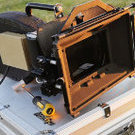
Pekka Riikonen
Basic Member-
Posts
11 -
Joined
-
Last visited
Profile Information
-
Occupation
Other
-
Location
Finland
Recent Profile Visitors
1,852 profile views
-
How saturated is "too saturated?"
Pekka Riikonen replied to Matthew W. Phillips's topic in Post Production
In this I pushed the saturation a lot but prevented the colors getting too bright. I also darkened the green a bit, for some reason... -
How saturated is "too saturated?"
Pekka Riikonen replied to Matthew W. Phillips's topic in Post Production
I think a good way to think about this is to ask the question, is the color surface color (reflective) or emissive color? Clearly the shirt in this picture isn't emissive light source, so it will look really unnatural if the red is so intense that it appears to emit light. There's few things you can do then. You can lower the saturation, or make the red also darker, or do both. Unfortunately most saturation controls still don't darken the colors automatically, you'll have to do it manually. There's a really great video from Filmlight, it really goes into details on this (the first 30 minutes): -
Heh, yeah, the 21mm f2 prices are nuts. I have 24mm f2 and paid about 350 euros I think, it was a while ago.
-
There's also the even more expensive Olympus OM Zuiko MC f2 series. They had a whole range that goes from 21mm f2 to 250mm f2. Zerooptik rehouses them https://zerooptik.com/zero-optik-rehousings/olympus-om I've got few of the f2 lenses and nothing but good things to say. I also have couple Minolta MC/MD Rokkor's but compared to Olympus I like the Olympus f2s better. Also, don't forget medium format lenses. With a speedbooster you can get the medium format angel of view on 35mm. Kipon makes 0.7x speedbooster with LPL mount (and other mounts).
-
Director’s viewfinder, need advice
Pekka Riikonen replied to Andreas Haglund's topic in General Discussion
How about Sigma FP. It has a dedicated mode for that. https://www.fdtimes.com/2019/10/20/sigma-fp-as-directors-viewfinder/ https://blog.sigmaphoto.com/2020/the-sigma-fp-as-a-directors-viewfinder/ -
Interior bedroom—lighting
Pekka Riikonen replied to Justin Oakley's topic in Lighting for Film & Video
I think the light falling on the desk, with the chair casting a shadow on it, adds depth and creates realism. The reason why I remembered this shot is because I paused to look at it, it was lit so beautifully. And then I had to try and figure out how it was actually lit. It's effective way of creating two looks. And even if the room didn't get warmer as the door opens, that might work for a story or for a character as well, keeping the room cold. -
Interior bedroom—lighting
Pekka Riikonen replied to Justin Oakley's topic in Lighting for Film & Video
This reminded me a shot in "Mrs Maisel" since I just watched it (I'm not sure it's ok to post screenshots so here's link to some website showing it: https://recapguide.com/recap/567/The-Marvelous-Mrs-Maisel/season-1/episode-4/#50). Here the shot was cool and got warm as the door was opened (warm lights on dimmers I assume) and then back to cool as it was closed again. -
:) Two books to read: "Modern Optical Engineering" by Warren J. Smith and "Modern Lens Design" by same author. Both available from Amazon.
-
I don't know if it can be fitted. I am not aware of such adapters. Of course if you can go so far as to modify the lens and/or the camera it sure can be fitted. It might not be possible with adapter, as finding Leica to _insert something here_ adapters are also hard to find (though there are few for other range finder cameras and some SLRs). I think the resolving power of the Leica is better than the Canon. The problem with that particular Leica lens I think is the vignetting and the coma. This probably can be attributed to the fact that leica had to design the lens as small as possible. It is, in fact heavier than the leica M6 camera itself and so is very special range finder camera lens (especially being just a standard lens). Canon doesn't have such issues with SLRs, and the Canon lens is over 300 grams heavier than the Leica, totalling over 1kg in weight. Not need to worry about size probably helped Canon. But I think you can expect some vignetting on Canon too at wide open. The Canon also doesn't have manual aperture ring which makes it bad for any other than Canon SLR use. Other, slower Leica 50mm are clearly better in every aspect compared to the Leica 50mm f/1.0. Though, stopping it down naturally helps a lot. Popular Photography has a short artice on the Canon: http://www.popphoto.com/assets/download/3112003113228.pdf And here's some on the Leica: http://www.imx.nl/photosite/leica/mseries/testm/M10-50.html http://www.vothphoto.com/spotlight/reviews/noctilux.htm Some other person on this thread asked how the lens design is affected by the aperture. The size of the lens is of course the direct result of a large aperture. And as far as I have understood it the diameter of the entrance pupil is derived as: entrance pupil = effective focal length / aperture so, for 50mm f/1.2, the entrance pupil diameter would be 41.6mm. For 50mm f/0.7 the entrance pupil diameter would be 71.4mm. That lens is going to be big. But, that's purely mathematical and theoretical. Other practical optical issues affect this as well so in practice it isn't this simple.
-
Are they any kind of a rare item, or worth anything ? Curious, saw one on my travels not long ago. -Sam I would say so. Any super fast lense, let it be f/1.0 or faster can be considered rare. Even the Leica f/1.0, that you can buy pretty easily as it is produced as of today by Leica would still be considered to be pretty rare. They don't make many of those and it will soon become a collector item (some in the Leica world think this is enough to buy it ;)). If you want that kind of lense, find one, _need one_, and the price isn't too much then go ahead and buy it. I forgot to mention that Canon also produces (or produced) 50mm f/1.0. I can't find it anymore from the Canon's website but I'm sure contacting them directly, they will sell it. I'm not sure though they are manufacturing them anymore too much. In some regards the Canon 50mm f/1.0 is better than the Leica. The Leica has clear vignetting wide open, which may be a problem or not, and it has coma issues. The coma is ugly on color images, but Ok in some B&W. I've never seen what it would look like in a 35mm film footage, it might be Ok. In terms of resolution the Leica I think is a bit better (now talking about shooting wide open). The Canon shouldn't have bad coma issues as far I know from sample images. The Canon 50mm f/0.95 was made in the sixties, so it's sixties glass and sixties design. That don't have to mean it's bad, it's probably pretty good. I don't have any first hand experience with that.
-
The following link may help to find more information about super fast lenses: http://www.abex.co.uk/sales/optical/fast_lenses/fast.htm Also, practical experience and photographs here with Rodenstock 50mm f/0.75: http://www.naturfotograf.com/need_speed00.html For practical and high quality use as of today, Leica is of course still manufacturing the infamous 50mm f/1.0 Noctilux that goes for about $3000 (instead of $4500 like I said earlier, actually). The lense is specificly designed to be high quality wide open without fear for soft images. I don't know about Leica to PL or some other mount adapter but, naturally if you know the right person such device can be constructed or the both camera and lense can be modified. http://www.leica-camera.com/imperia/md/con...bjektive/14.pdf Nikon also has developed Noctilux lense a while back but I don't think they are available anymore. They still do however sell the 50mm f/1.2 which is great wide open. Though, f/1.2 and f/1.0 or below is a big difference. :) Canon also used to make 50mm f/0.95 in the sixties but it's not available anymore.





